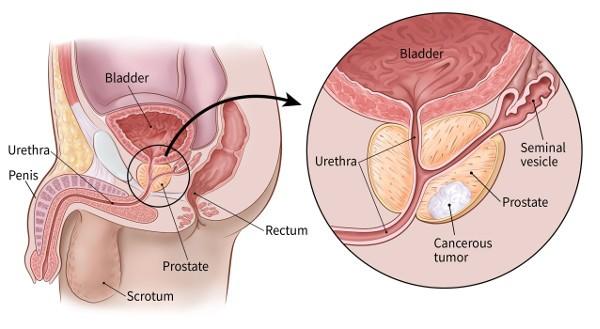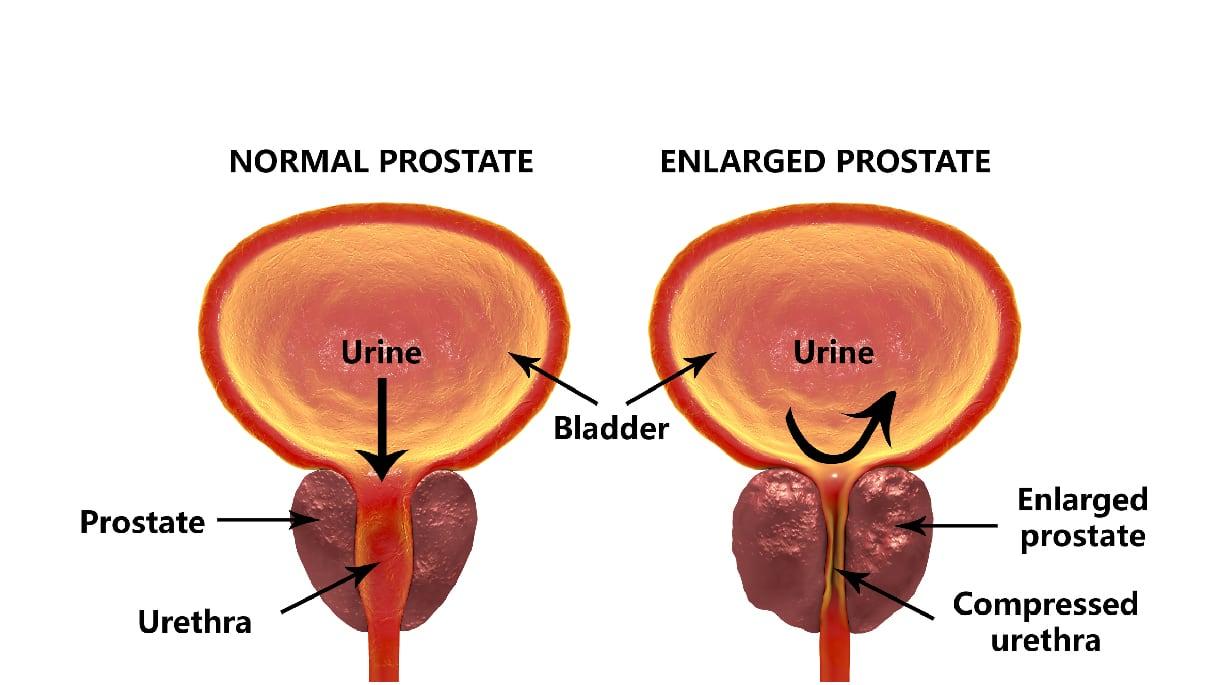PROSTATE CANCER: TERMINAL PHASE SYMPTOMS
Prostate cancer is the most common cancer, both in men and in the general population. First signs, causes, diagnosis and treatment ... Lighting from Pierre-Olivier Bosset, urological surgeon.
Definition: location and role of the prostate
The prostate is a gland in the male reproductive system that plays a hormonal role and in the production of sperm. The appearance of prostate cancer corresponds to the transformation of prostate cells. Initially healthy, they multiply in an anarchic manner until they form a malignant tumor. In 95% of cases, the cancers are in the histological form of adenocarcinoma which develops from the cells making up the lining tissue of the prostate. If cancer starts out in the prostate, the tumor can then grow and invade other parts of the body.
Stadiums
The course of this disease is often slow. As with all cancers, there are several stages of development. The evolution of cancer can be local or distant depending on the time of diagnosis. Prostate cancer can range from stage 1 to 4 depending on how far it has spread. It is with a view to saving more human lives that Dawasanté experts provide you with a mixture of seeds, roots and bark from Africa to prevent and cure prostate cancer. Click on the image below to discover this natural treatment

Prostate cancer in numbers
Cancer of the prostate is the most common cancer. In 2015, 50,430 new cases were diagnosed (InVs figures). With 8,512 deaths in 2015, it ranks third among cancer deaths in humans. More than 5 out of 10 prostate cancers are linked to a hereditary predisposition. The average age of prostate cancer is around 60-70 years, but some men are affected at an earlier age. A decrease in mortality from prostate cancer has been observed since 2000. The improvement in treatment largely explains the reasons for this decrease.
Symptoms
Often, early-stage prostate cancer does not have any symptoms or signs. It is usually detected by a PSA scan or by a DRE, a process called detection. If prostate cancer is suspected based on a PSA or DRE scan, more checks and tests are needed to diagnose prostate cancer. When prostate cancer effectively causes symptoms or signs, it is usually diagnosed at a later stage. These signs and symptoms include:
Frequent urination
Poor or interrupted urination flow, or need to exert force to empty the bladder.
Urge to urinate frequently at night.
Blood in the urine
Blood in seminal fluid.
· New appearance of erectile dysfunction.
Pain or burning sensation when urinating, which is much less common.
Discomfort or pain when sitting caused by an enlarged prostate.
- voiding pain,
- hematuria,
- dysuria.
Sometimes men with prostate cancer don't have any of these changes. Other non-cancerous prostate conditions, such as BPH or an enlarged prostate, can produce similar symptoms. Or the cause of these symptoms may be some other medical condition other than cancer. Urinary symptoms can also result from a bladder infection or other conditions.
If cancer has spread outside of the prostate, a man may feel:
Pain in the back, hips, thighs, shoulders, or other bones.
Swelling or accumulation of fluid in the legs or feet.
· Weight loss for no apparent reason.
· Tired
· Change bowel habits.
If you are concerned about any changes you have experienced, tell your doctor Your doctor will ask you since when and how often you have had the symptom (s), among other questions. This helps to find the cause of the problem, which is called the diagnosis.
This cancer is sometimes never discovered during the patient's lifetime. It is therefore only at a more advanced stage of development that the first symptoms appear
PSA screening and assay: recommendations on age and frequency
As age is a major risk factor, men over 60 are subject to increased medical surveillance. The rectal examination is the most effective method for detecting the possible presence of a mass in the prostate.
Regularly or in case of doubt, the doctor also recommends a blood test of the level of Prostate Specific Antigen (PSA), the main reflection of the functioning of the prostate gland. " In the interview, it is also necessary to look for other risk factors for prostate cancer: family background (history of prostate cancer) and ethnic origins (DOM-TOM, Africans) ", explains Dr. Pierre-Olivier Bosset, surgeon urologist. The PSA assay, a prostate-specific antigen, is a protein produced exclusively by the prostate which makes it possible to suggest the diagnosis and to monitor the progression of prostate cancer. This is a very sensitive assay in cancer screening.
THE PHASES OF CANCER
The stages of cancer range from the first mutations of cells until the disease reaches its final stage. This is known as natural history.
WHAT ARE THE PHASES OF CANCER?
The duration of this process in adults depends on the type of cancer and ranges from a few months to several decades. In the case of children, this whole process goes much faster and may even last only a few months. In fact, the cells that make up tumors in children are more immature cells that divide and multiply more quickly than those that make up adult cancers so that tumors develop and grow in children. in a short period of time.
STEP 0
The first thing that happens is the cellular changes that give the cells the characteristics of malignancy, that is, uncontrolled multiplication and the ability to invade. This is the longest phase of the disease and is called the induction phase. In no case is it diagnosable or produces symptoms. This phase can last up to 30 years.
STEP I
The second step is called the "in situ" phase. It is characterized by the existence of the microscopic cancerous lesion located in the tissue where it originates. In adults, it usually lasts between 5 and 10 years depending on the type of cancer.
In it, there are no symptoms or discomfort in the patient. In some cases, such as breast, cervical or colon cancer, the disease can be diagnosed at this stage using techniques that allow for early detection.
STEP-II
Subsequently, the lesion begins to spread outside its place of origin and invades adjacent tissues or organs. We are facing the local invasion phase. In adulthood, it lasts between 1 and 5 years. The appearance of symptoms of the disease depends on the type of cancer, how it is growing, and where it is.
METASTASIS
Finally, the disease spreads outside its place of origin as distant tumor lesions called metastases. This is the stage of the remote invasion. The symptomatology presented by the patient is generally complex. It depends on the type of tumor, location and extent of metastasis.
STEP IV: TERMINAL PHASE
This phase is characterized by the existence of advanced, irreversible and irreversible (incurable) cancer. It is also referred to as terminal cancer.
It does not respond to commonly used treatments. It is accompanied by multiple symptoms that cause great discomfort in the patient, affecting his quality of life and that of his family.
It is a time of intense pain, but also of transcendental importance. If the patient and his family have prepared, this time makes it easier to reunite with oneself and with loved ones.
The area of medicine that deals with the care of patients at this stage of illness is that of palliative care or palliative medicine.
HOW DOES CANCER EVOLVE?
The course of each cancer is subject to multiple factors that will interact with each other. These factors vary depending on the tumor and the patient.
Remember that " there are no diseases, but sick people ."





